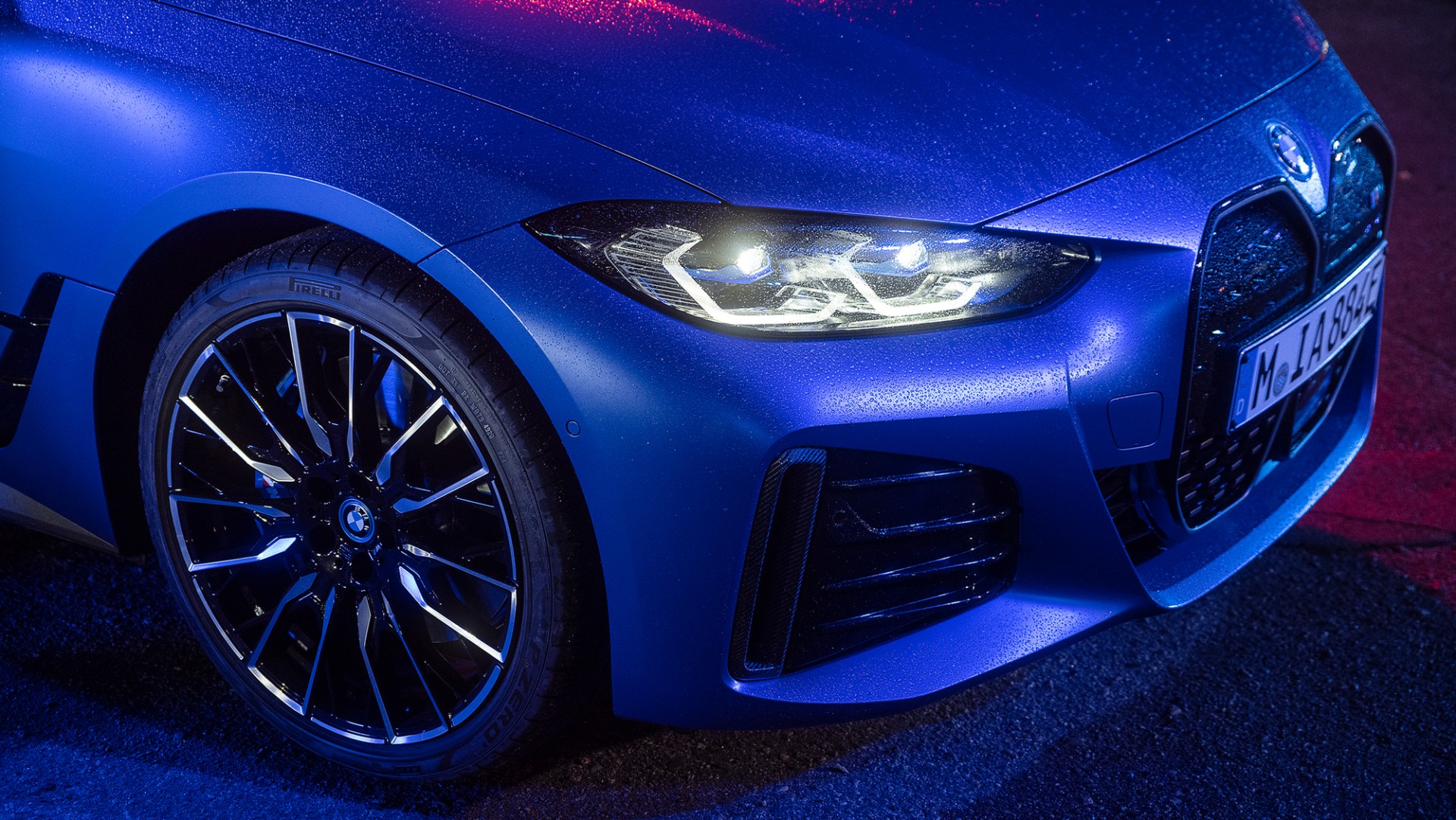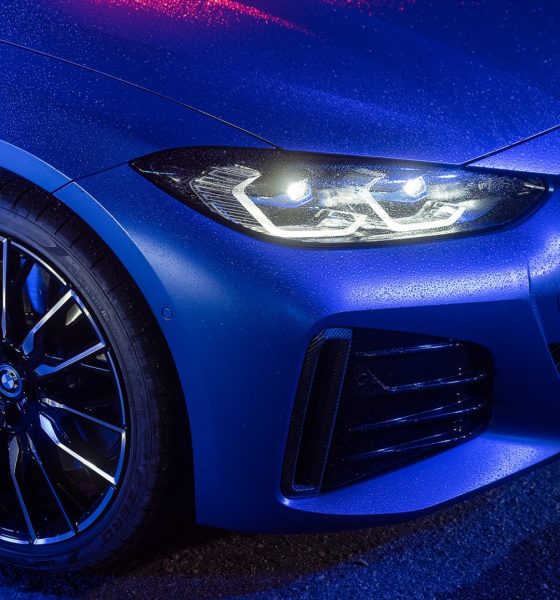

News
BMW chooses Pirelli’s EV-geared P Zero tire for i4 M50’s high-performance powertrain
BMW and Pirelli will outfit the German automaker’s i4 M50 all-electric vehicle with the Italian tyre manufacturer’s P Zero Elect rubber, which is geared for high-performance electric powertrains.
Putting that perfect set of fresh rubber tires on your favorite car doesn’t just make it handle like it’s on rails and give you a renewed appreciation for seat belts; it’ll brighten your whole day. Sadly, picking that perfect set and getting that “fresh rubber” feeling has become increasingly complex in the electrified age. Thankfully, BMW and Pirelli have partnered to tackle that issue on the BMW i4 M50.
? The #Pirelli P Zero Elect has been selected by @BMW M to equip the new BMW i4 M50, to deliver maximum performance even during extreme sports driving. https://t.co/rif71aeR9s
— Pirelli (@Pirelli) January 25, 2023
Everybody knows EV-specific tires can help make a car handle better, smoother, and more efficient. Still, oddly enough, the tires that come straight from the dealer are often run-of-the-mill, bog standard, and often lacking in the performance department. Not the case with Pirelli’s new P Zero Elect, which will be available on the BMW i4 M50.
This brings us to the BMW i4’s biggest problem, its weight. Far from the nimble sportscar standard of 90s BMW products, the i4 M50 comes in at an earth-shattering 5,018 pounds. The problem is so significant that it has become car reviewers’ and vehicle owners’ common talking point.
Hence the involvement of Pirelli.
More than making the vehicle carve like a knife, tires can affect how a vehicle handles its weight. Pirelli said, “The structure of the Pirelli tire has been reinforced to support the car and deliver maximum performance even during extreme sports driving.” Furthermore, “the special high-grip compound has also been designed to give maximum grip to guarantee precise and efficient handling,” explains Pirelli.
In essence, though a reinforced structural design and a new compound, Pirelli has given the vehicle a more planted feel through its specific design, helping reduce some of the i4’s momentous weight issues. But this isn’t the first vehicle Pirelli has worked to improve the handling of.
Pirelli’s “Elect” variant of tires, specifically designed for EVs, have been integrated into each of the company’s notable product offerings: P Zero, Cinturato, and Scorpion. In turn, it has attracted manufacturers like Ford and its Mustang Mach-E, Rivian with its R1S, and even Porsche and its first EV, the Taycan.
The Italian tire titan has a long history of fitting specialized tires to BMW’s M-cars. Its newest product shows that it intends to do the same with the German performance brand’s electric offerings. More exciting still is the idea that Pirelli is finally working towards EV tires that aren’t just for getting the most range but can be used for more “spirited” driving. Let’s hope other tire manufacturers aren’t far behind.
What do you think of the article? Do you have any comments, questions, or concerns? Shoot me an email at william@teslarati.com. You can also reach me on Twitter @WilliamWritin. If you have news tips, email us at tips@teslarati.com!

Investor's Corner
Tesla stock closes at all-time high on heels of Robotaxi progress

Tesla stock (NASDAQ: TSLA) closed at an all-time high on Tuesday, jumping over 3 percent during the day and finishing at $489.88.
The price beats the previous record close, which was $479.86.
Shares have had a crazy year, dipping more than 40 percent from the start of the year. The stock then started to recover once again around late April, when its price started to climb back up from the low $200 level.
This week, Tesla started to climb toward its highest levels ever, as it was revealed on Sunday that the company was testing driverless Robotaxis in Austin. The spike in value pushed the company’s valuation to $1.63 trillion.
Tesla Robotaxi goes driverless as Musk confirms Safety Monitor removal testing
It is the seventh-most valuable company on the market currently, trailing Nvidia, Apple, Alphabet (Google), Microsoft, Amazon, and Meta.
Shares closed up $14.57 today, up over 3 percent.
The stock has gone through a lot this year, as previously mentioned. Shares tumbled in Q1 due to CEO Elon Musk’s involvement with the Department of Government Efficiency (DOGE), which pulled his attention away from his companies and left a major overhang on their valuations.
However, things started to rebound halfway through the year, and as the government started to phase out the $7,500 tax credit, demand spiked as consumers tried to take advantage of it.
Q3 deliveries were the highest in company history, and Tesla responded to the loss of the tax credit with the launch of the Model 3 and Model Y Standard.
Additionally, analysts have announced high expectations this week for the company on Wall Street as Robotaxi continues to be the focus. With autonomy within Tesla’s sights, things are moving in the direction of Robotaxi being a major catalyst for growth on the Street in the coming year.
Elon Musk
Tesla needs to come through on this one Robotaxi metric, analyst says
“We think the key focus from here will be how fast Tesla can scale driverless operations (including if Tesla’s approach to software/hardware allows it to scale significantly faster than competitors, as the company has argued), and on profitability.”

Tesla needs to come through on this one Robotaxi metric, Mark Delaney of Goldman Sachs says.
Tesla is in the process of rolling out its Robotaxi platform to areas outside of Austin and the California Bay Area. It has plans to launch in five additional cities, including Houston, Dallas, Miami, Las Vegas, and Phoenix.
However, the company’s expansion is not what the focus needs to be, according to Delaney. It’s the speed of deployment.
The analyst said:
“We think the key focus from here will be how fast Tesla can scale driverless operations (including if Tesla’s approach to software/hardware allows it to scale significantly faster than competitors, as the company has argued), and on profitability.”
Profitability will come as the Robotaxi fleet expands. Making that money will be dependent on when Tesla can initiate rides in more areas, giving more customers access to the program.
There are some additional things that the company needs to make happen ahead of the major Robotaxi expansion, one of those things is launching driverless rides in Austin, the first city in which it launched the program.
This week, Tesla started testing driverless Robotaxi rides in Austin, as two different Model Y units were spotted with no occupants, a huge step in the company’s plans for the ride-sharing platform.
Tesla Robotaxi goes driverless as Musk confirms Safety Monitor removal testing
CEO Elon Musk has been hoping to remove Safety Monitors from Robotaxis in Austin for several months, first mentioning the plan to have them out by the end of 2025 in September. He confirmed on Sunday that Tesla had officially removed vehicle occupants and started testing truly unsupervised rides.
Although Safety Monitors in Austin have been sitting in the passenger’s seat, they have still had the ability to override things in case of an emergency. After all, the ultimate goal was safety and avoiding any accidents or injuries.
Goldman Sachs reiterated its ‘Neutral’ rating and its $400 price target. Delaney said, “Tesla is making progress with its autonomous technology,” and recent developments make it evident that this is true.
Investor's Corner
Tesla gets bold Robotaxi prediction from Wall Street firm
Last week, Andrew Percoco took over Tesla analysis for Morgan Stanley from Adam Jonas, who covered the stock for years. Percoco seems to be less optimistic and bullish on Tesla shares, while still being fair and balanced in his analysis.

Tesla (NASDAQ: TSLA) received a bold Robotaxi prediction from Morgan Stanley, which anticipates a dramatic increase in the size of the company’s autonomous ride-hailing suite in the coming years.
Last week, Andrew Percoco took over Tesla analysis for Morgan Stanley from Adam Jonas, who covered the stock for years. Percoco seems to be less optimistic and bullish on Tesla shares, while still being fair and balanced in his analysis.
Percoco dug into the Robotaxi fleet and its expansion in the coming years in his latest note, released on Tuesday. The firm expects Tesla to increase the Robotaxi fleet size to 1,000 vehicles in 2026. However, that’s small-scale compared to what they expect from Tesla in a decade.
Tesla expands Robotaxi app access once again, this time on a global scale
By 2035, Morgan Stanley believes there will be one million Robotaxis on the road across multiple cities, a major jump and a considerable fleet size. We assume this means the fleet of vehicles Tesla will operate internally, and not including passenger-owned vehicles that could be added through software updates.
He also listed three specific catalysts that investors should pay attention to, as these will represent the company being on track to achieve its Robotaxi dreams:
- Opening Robotaxi to the public without a Safety Monitor. Timing is unclear, but it appears that Tesla is getting closer by the day.
- Improvement in safety metrics without the Safety Monitor. Tesla’s ability to improve its safety metrics as it scales miles driven without the Safety Monitor is imperative as it looks to scale in new states and cities in 2026.
- Cybercab start of production, targeted for April 2026. Tesla’s Cybercab is a purpose-built vehicle (no steering wheel or pedals, only two seats) that is expected to be produced through its state-of-the-art unboxed manufacturing process, offering further cost reductions and thus accelerating adoption over time.
Robotaxi stands to be one of Tesla’s most significant revenue contributors, especially as the company plans to continue expanding its ride-hailing service across the world in the coming years.
Its current deployment strategy is controlled and conservative to avoid any drastic and potentially program-ruining incidents.
So far, the program, which is active in Austin and the California Bay Area, has been widely successful.








